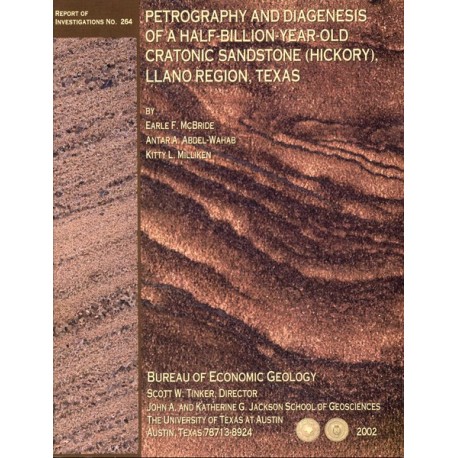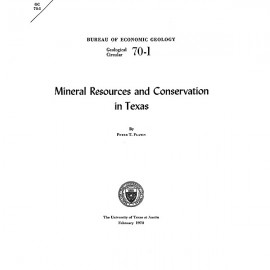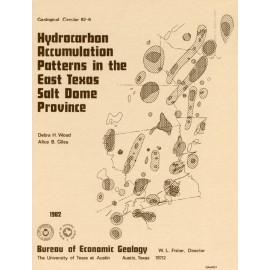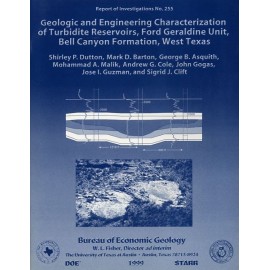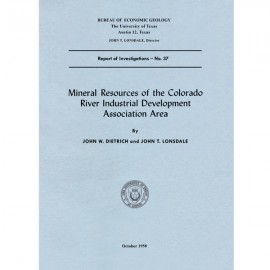Reports of Investigations
-
Books & Reports
- Reports of Investigations
- Guidebooks
- Udden Series
- Geological Circulars
- Down To Earth
- Atlases of Major Oil and Gas Reservoirs
- Texas Memorial Museum Publications
- Environmental Geologic Atlas of the Texas Coastal Zone
- Mineral Resource Circulars
- Other Reports
- Seminars and Workshops
- Handbooks
- Submerged Lands of Texas
- Symposia
- Annual Reports
- Open File Reports
-
Maps & Cross Sections
- Thematic Maps
- Miscellaneous Maps, Charts & Sections
- Geologic Atlas of Texas
- STATEMAP Project Maps
- Geologic Quadrangle Maps
- Cross Sections
- Highway Geology Map
- Energy and Mineral Resource Maps
- Shoreline Change and Other Posters
- Wilcox Group, East Texas, Geological / Hydrological Folios
- Bouguer Gravity Atlas of Texas
- River Basin Regional Studies
- Featured Maps
- Posters
- Teachers & the Public
-
Geological Society Publications
- Gulf Coast Association of Geological Societies
- Alabama Geological Society
- Austin Geological Society
- Corpus Christi Geological Society
- Houston Geological Society
- Lafayette Geological Society
- Mississippi Geological Society
- New Orleans Geological Society
- South Texas Geological Society
- GCS SEPM Publications
- Historic BEG & UT Series
Petrography and Diagenesis of a Half-Billion-Year-Old Cratonic Sandstone (Hickory), Llano Region, Texas
RI0264
Petrography and Diagenesis of a Half-Billion-Year-Old Cratonic Sandstone (Hickory), Llano Region, Texas, by E. F. McBride, A. A. Abdel-Wahab, and K. L. Milliken. 77 p., 66 figs., 7 tables, 1 appendix, 2002. Print Version.
For a downloadable, digital version: RI0264D.
RI0264. Petrography and Diagenesis of a Half-Billion-Year-Old Cratonic Sandstone (Hickory), Llano Region, Texas, by E. F. McBride, A. A. Abdel-Wahab, and K. L. Milliken. 77 p., 66 figs., 7 tables, 1 appendix, 2002. Print.
To purchase this publication as a downloadable PDF, please order RI0264D.
ABSTRACT
We studied the Hickory Sandstone Member of the Riley Formation, Central Texas, to assess the diagenetic history of a cratonic sandstone, which, in spite of its great age, remains porous and permeable where it has not been buried more than 1 km. Owing to its stratigraphic position between Precambrian basement and overlying, low-permeability carbonate rocks, the Hickory was a potential pathway for fluids expelled from the Ouachita orogen. Although sandstones contain 20 authigenic phases, they show no evidence of extensive hot-fluid metasomatism typical of some other basal Cambrian cratonic sandstones. Iron oxide and calcite are the only volumetrically important authigenic phases, although authigenic quartz is abundant in local silcretes and in deformation bands. Quartz cement fills most pores in sandstones buried deeper than 3 km.
The Hickory Sandstone, as much as 150 m thick, comprises chiefly marine sandstone with minor mud rock, conglomerate, and limestone, plus an ironstone unit 25 m thick. Sandstone is subarkose, arkose, and diagenetic quartzarenite, in which most or all feldspar was lost diagenetically. Although sediment was derived ultimately from the Precambrian basement, some was reworked from fluvial deposits and eolian dunes. Syndepositional authigenic phases are cellophane as cement, grain coats, and nodules; glauconite; aragonite; and either goethite or berthierine, the latter of which apparently quickly altered to goethite. Inferred berthierine ooids and berthierine-replaced carbonate shells probably formed a few centimeters below the sediment-water interface in anoxic muds but were episodically exhumed and oxidized to goethite before ultimate burial. Authigenic phases introduced during the initial burial phase, which lasted until the end of Early Ordovician time, are K-feldspar, siderite?, calcite, chlorite, and possibly some quartz.
During deepest burial, possibly during the Middle Pennsylvanian, quartz cement and replacement dolomite were introduced. Dolomite was partly replaced by ferroan dolomite, whereas early calcite was replaced by ankerite. Hydrocarbons or H2S generated at this time invaded parts of the Hickory and reduced ferric iron to yield pyrite and simultaneously bleached beds by removing iron-oxide grain coats from sandstones and mud rocks. Uplift and erosion from the Permian through the Jurassic brought the Hickory close to the surface in places until it was reburied by Cretaceous rocks. Influx of meteoric water permitted the precipitation of a late-stage, spotty calcite cement, chiefly in the form of pea-sized concretions.
Meteoric water again invaded the Hickory when the Llano region was uplifted farther in the Neogene and became responsible for the formation of local ferricretes, silcretes, precipitation of minor kaolinite and opal, and the dissolution of about 5 percent feldspar and an indeterminate amount of calcite. In terms of mass balance, (1) calcium and some bicarbonate for calcite cement were probably derived from carbonate components in the upper Hickory and overlying carbonates; (2) iron oxide, partly syndepositional, was produced partly by oxidation of biotite and amphibole; (3) during diagenesis, silica for normal quartz cement was generated by intergranular pressure dissolution of detrital quartz; (4) silica for silcrete was derived from the weathering of Precambrian and Paleozoic rocks in the Llano region and was precipitated by meteoric water; and (5) most of the aluminum released from the late-stage dissolution of detrital feldspar left the system. In shallow-buried Hickory sandstones, the combination of primary and secondary pores yields excellent aquifer porosities and permeabilities, but healed fractures and deformation bands produce permeability compartments.
Keywords: arkose, calcite cement, feldspar overgrowths, ironstone, quartz cement, silcrete
CONTENTS
Abstract
Introduction
Problem
Scope and Methods
Geologic Setting, Stratigraphy, and Sedimentology
Burial and Thermal History
Rock Types and Color
Sandstone Petrography
General Comments
Framework Composition
Matrix
Cement
Porosity and Permeability
Oolitic Ironstone
Deeper Cores (Nos. 6, 7, and 8)
Mud-Rock Petrography
Regional and Stratigraphic Variations
Provenance and Paleoclimate
Sandstone Diagenesis
General Comments
Iron Oxides
Description
Interpretation of Nonoolitic Beds
Interpretation of Oolitic Ironstone Beds
Quartz Cement-Common Sandstones
Quartz Cement-Deformation Bands
Quartz Cement-Silcretes
Calcite
K-Feldspar
Dolomite, Ferroan Dolomite, and Ankerite
Other Carbonates-Aragonite, Siderite, and Rhodochrosite
Collophane and Glauconite
Clay Minerals-Chlorite. Kaolinite, Illite, and Smectite
Anatase
Bleaching and Pyrite
Opal
Compaction and Sutured Grains
Dissolution
Sequence of Events
Discussion and Summary
Acknowledgments
References
Appendix 1. Cores examined
Figures
1. Map of study area
2. Graphic logs of cores sampled during this study
3. Stratigraphic and biostratigraphic relations of the Riley Formation
4. Calcite-cemented sandstone from the ironstone facies
5. SEM image of surface of well-rounded quartz grain from the ironstone facies
6. Friable, porous, poorly cemented sandstone with bimodal texture
7. Slabbed core showing foresets of crossbedding in sandstone having a bimodal texture
8. Burial-history diagram of the Hickory Member, Riley Formation
9. Color-mottled pebble-conglomerate beds of core 5
10. Iron-oxide Liesegang bands, which developed in facies 3 of core 3 at a depth of 120 m
11. Sandstone from top of ironstone facies showing geopetal fabric and precompactional calcite cement
12. SEM micrograph of well-rounded sandstone from ironstone facies
13. Sutured quartz-grain contact resulting from pressure dissolution
14. Scanned CL image showing intensely fractured detrital quartz grain in contact with undeformed neighbors
15. Sandstone composition plotted on QFR triangle of Folk
16. SEM view of K-feldspars showing dissolution micropores
17. Skeletal perthite grain resulting from intergranular dissolution of albite laminae and collapse of K-feldspar laminae
18. Microcrystalline quartz rock fragment
19. Lingulid brachiopods broken by compaction
20. Granule-size intrabasinal clast of sandstone cemented by cellophane
21. Distribution of thin-section porosity versus depth for 158 samples
22. Cross plot of vertical permeability versus porosimeter porosity for various Hickory sandstone samples from shallow cores
23. Cross plot of vertical versus horizontal permeability for various Hickory sandstone samples from shallow cores
24. Deformation band that developed along a high-angle fault
25. Cross plot of porosity measured in thin section versus porosity measured by porosimeter for the same samples
26. Photomicrograph of sandstone tightly cemented by quartz from a depth of 2,077 m
27. Ironstone sample completely cemented by calcite
28. SEM view of broken goethite ooid showing concentric laminae from ironstone facies
29. Photomicrograph of polished section in reflected light of iron-oxide ooid, adjacent detrital quartz grains, and calcite cement
30. Compound iron-oxide ooid in an unpolished thin section viewed in reflected light
31. Photomicrograph of thin section of ironstone sample having grain coats of hematite of variable thickness
32. Botryoidal goethite in ferricrete at base of Hickory
33. Clusters of starburst goethite crystals sitting on scaly quartz overgrowths
34. Enlargement of clusters of starburst goethite crystals
35. Goethite, in the form of spheroids and starbursts, resting on authigenic K-feldspar and clay
36. Cauliflowerlike masses of goethite resting on quartz overgrowths
37. Spheroids and starbursts of goethite forming curved chains that are possibly fungal hyphae
38. Cluster of probable bacteria resting on a plate of goethite having bulblike ends
39. Abundance of quartz cement versus depth of sample
40. Cross plots of abundance of quartz and calcite cement versus intergranular volume
41. SEM micrograph showing quartz grain covered by thin layer of chlorite, on top of which rest incipient overgrowths of quartz
42. Thin quartz overgrowths that have not developed beyond the scaly stage
43. Rosettes of goethite resting on scaly, imperfect faces of quartz overgrowths
44. Sandstone sample from core 6 at a depth of 2,077 m
45. CL image of deformation band showing crushed quartz at grain contacts
46. CL image showing bimodal grain size of fragments of crushed detrital quartz grains
47. Images showing texture and composition of deformation band
48. Silcrete cemented by combination of normal overgrowths and microcrystalline quartz
49. Oversize pore filled by intergrowths of authigenic quartz, K-feldspar, and illite in silcrete
50. Photomicrograph of silcrete showing oriented fluid inclusions in quartz overgrowth
51. Scanned CL image of silcrete showing multiple light-dark zones in quartz overgrowths
52. Photomicrograph of silcrete containing euhedral crystals of anatase rimming a detrital quartz grain
53. Rhombic grains of carbonate, probably siderite, that have been replaced by calcite
54. Plot of carbon and oxygen isotopic data
55. Spheroidal, pea-sized concretions of late-stage calcite cement
56. Late-stage calcite cement that also shredded mica grains by growing displacively along cleavage
57. Detrital K-feldspar grain displaying typical rhombic euhedral overgrowths
58. SEM micrograph showing euhedral overgrowth on detrital K-feldspar
59. Paired images showing extent of authigenic K-feldspar within a grain
60. Images showing presence of authigenic K-feldspar within fractures in K-feldspar in granite
61. Sandstone cemented first by isopachous cellophane, followed by final pore-fill stage
62. SEM image of chlorite coating detrital quartz grain, goethite coating quartz overgrowths, and late-stage calcite cement
63. Layer of authigenic chlorite that coats detrital quartz grain
64. SEM image of cluster of authigenic anatase crystals
65. Plot of IGV versus depth for shallow samples
66. Detrital quartz grains beneath tabular lingulid fragment, composed of organo-phosphate, showing perfectly flat tops resulting from severe pressure dissolution
Tables
1. Facies of the Hickory and environmental interpretation
2. Point-count data for Hickory sandstones
3. Microprobe analyses of feldspar
4. Feldspar composition anomaly
5. Carbon, oxygen, and strontium isotopic data for authigenic carbonate
6. Elemental composition of authigenic carbonate
7. Mass balance of K-feldspar and reaction products
Citation
McBride, E. F., Abdel-Wahab, A. A., and Milliken, K. L., 2002, Petrography and Diagenesis of a Half-Billion-Year-Old Cratonic Sandstone (Hickory), Llano Region, Texas: The University of Texas at Austin, Bureau of Economic Geology, Report of Investigations No. 264, 77 p.
